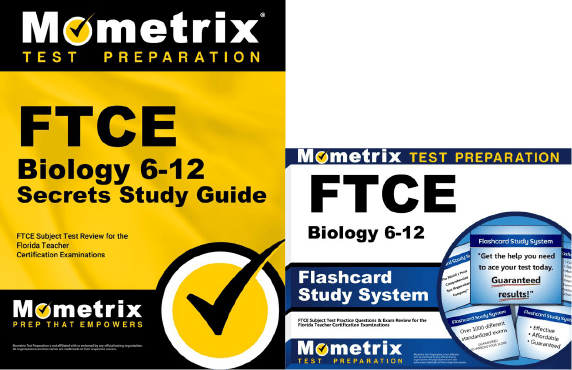If you need help studying for the FTCE Biology 6-12 test or just want some more information about what the test is like, you’ve come to the right place!
Click below to take a free FTCE Biology 6-12 practice test!
What’s on the Test?
The FTCE Biology 6-12 test contains 80 multiple-choice questions and is timed at 2.5 hours.
The exam is split into 10 competencies:
1. The Investigative Processes of Science
18% of the exam
- Light microscope components and use
- Types of microscopy and their applications
- Common lab procedures
- Proper techniques for field studies
- Calculating measurements in the appropriate metric units
- Knowing the difference between, laws, theories, conclusions, hypotheses, observations, inferences, and assumptions
- Interpreting empirical data
- Scientific vs. nonscientific knowledge
- Relationships between variables and possible outcomes
- Relating the validity of scientific knowledge to statistical significance, technological limitations, reproducibility, bias, and types of error
- The development of biological theories and knowledge
- Qualitative and quantitative data
- Elements of a well-designed and controlled experiment
- The dynamic nature of science
- Patterns that govern the occurrence of natural events
2. Interactions Between Science, Technology, and Society
4% of the exam
- Ethical, legal, social, and economic implications of scientific research and practices
- Environmental challenges that may result from advances in science and technology
- The effects of globalization on pathogens and invasive species
- Pertinent legislation and national guidelines surrounding lab safety, hazardous materials, and using organisms in the classroom
3. The Chemical Processes of Living Things
14% of the exam
- Structures and functions of organic and inorganic compounds
- Applying the laws of thermodynamics to living systems
- The effects of various variables on reaction rate
- Substrates, products, and relationships in aerobic respiration
- End products and energy yields of aerobic and anaerobic respiration
- Raw materials and products of C3 photosynthesis
- Key differences between C3, C4, and CAM photosynthesis
- The role of chemiosmosis in respiration and photosynthesis
- Comparing heterotrophy and autotrophy
- Evaluating antigen-antibody reactions
- Active and passive immunity
- The roles of cell recognition in cell activity
- The effect of environmental factors on biochemistry
- The roles of ATP and ADP
- Chemosynthetic and photosynthetic processes
- Cell-to-cell communication
- Immune responses to vaccines and inoculations
4. Interactions Between Cell Structure and Cell Function
7% of the exam
- Major scientists and events that contributed to the development of the cell theory
- Major structural characteristics of prokaryotic and eukaryotic cells
- The structure of cell organelles
- The events of each phase of the cell cycle
- Mechanisms and results of nuclear division
- Characteristics of the major taxa
- Relationships between the structures and functions of cell membrane components
- Active and passive cellular transport mechanisms
5. Genetic Principles, Processes, and Applications
11% of the exam
- Structure and function in nucleic acids
- DNA replication
- Protein synthesis
- The functions of DNA and RNA
- Regulatory systems for prokaryotic and eukaryotic protein synthesis
- Proper techniques for recombinant DNA technology
- Environmental and genetic influences on gene structure and expression
- Meiosis in plants, animals, and fungi
- Mendelian laws of inheritance
- Probability and statistical analysis in genetics
- Patterns of inheritance
- Causes of genetic disorders
- The effect of a mutation in a DNA sequence on the products of protein synthesis
6. The Structural and Functional Diversity of Viruses and Prokaryotic Organisms
4% of the exam
- The structure and function of viruses and prokaryotic organisms
- The effects of viruses on organisms
- The structures and functions of prokaryotes
- Major types of bacterial genetic recombination
- Microbial processes and products
7. The Structural and Functional Diversity of Protists, Fungi, and Plants
8% of the exam
- Major types of protists, fungi, and plants
- Effects of protists, fungi, and plants on other living things
- The structures of specialized plant tissues
- Characteristics of vascular and nonvascular plants
- The functions of the major organs of angiosperms and gymnosperms
- The structures of monocots and dicots
- Major mechanisms in plants
- The role of major plant growth regulators
- Methods of reproduction in plants
- Patterns of alternation of generations in plants, fungi, and algae
8. The Structural and Functional Diversity of Animals
13% of the exam
- Structures of animal tissue types
- Major animal body plans
- The stages, sequence, and processes of differentiation in embryological development for representative animal phyla
- he structures of the various body systems
- The contribution of the body systems to the human immune response
- The interconnectedness of animal organ systems
- The effects of positive and negative feedback loops in human systems
- Aspects of animal social behavior
9. Ecological Principles and Processes
11% of the exam
- Knowing the difference between individuals, populations, communities, ecosystems, biomes, and the biosphere
- The relationship between organisms and their trophic levels
- Organisms in the hydrologic, carbon, nitrogen, and phosphorous cycles
- Patterns of energy flow in an ecosystem
- Factors that affect population composition, growth, size, and geographic distribution
- Classifying examples of species interactions
- Primary and secondary succession in biotic communities
- Costs and benefits of managing renewable and nonrenewable resources
- The effects of human population size, resource use, and technology on environmental quality
- Consequences of loss of biodiversity
- Biotic and abiotic components that define Florida’s ecosystems
10. Evolutionary Mechanisms
10% of the exam
- Comparing the current theory of evolution with previous theories
- Exceptions to and limitations of the biological species concept
- Systems of classification
- Applying a taxonomic key
- Variation within a species along an environmental cline
- Factors affecting speciation
- Various roles in evolution
- Punctuated equilibrium and gradualism
- Examples of evidence for evolutionary theory
- Aspects of modern scientific theories
- Patterns of evolutionary change
- The Hardy-Weinberg equilibrium
- Basic trends in hominid evolution from early ancestors to modern humans
How to Register
To get started with the registration process, you’ll need to create an FTCE/FELE account on their website. You can then register for the exam via your account.
How the Exam is Scored
The FTCE Biology 6-12 test is scored using a scaled scoring method. Here’s how it works:
For every question you answer correctly, you get one point added to your raw score. At the end of the test, your final raw score will be converted to a scaled score.
The reason your raw score is converted to a scaled score is because everyone that takes the test is given a slightly different set of questions. Since everyone has a different arrangement of questions, and because some questions are harder than others, converting your raw score to a scaled score ensures a more even playing field.
FAQs
How many questions are on the FTCE Biology 6-12 exam?
The exam contains 80 multiple-choice questions.
What is the time limit for the FTCE Biology 6-12 exam?
The exam is timed at 2.5 hours.
What is the passing score for the FTCE Biology 6-12 exam?
You’ll need to get a final score of at least 200 to pass.
How much does the FTCE Biology 6-12 exam cost?
The testing fee is $150.
Mometrix Test Preparation is not affiliated with or endorsed by any official testing organization. All organizational and test names are trademarks of their respective owners.



 FTCE Study Guide
FTCE Study Guide FTCE Flashcards
FTCE Flashcards